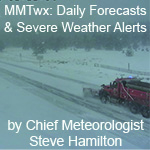- Posts: 28
- Thank you received: 7
Red Cross Snowmobiling on Ice
- sweetiepie648
-
 Topic Author
Topic Author
- Leaf Peeper
-

Less
More
23 Jan 2018 16:57 #1
by sweetiepie648
Red Cross Snowmobiling on Ice was created by sweetiepie648
Red Cross Snowmobiling on Ice
volunteer Michelle Adams
Snowmobiling on ice
Each year, tragic and avoidable snowmobile deaths occur. Snowmobiles are high-speed vehicles that operate in a
hazardous natural environment. Riders are at risk of personal injury and fatalities due to collisions and immersion
in cold water.
Important facts
Red Cross’ ongoing surveillance of unintentional water-related fatalities tracked 398 snowmobile-related deaths over a period
of 20 years and found that snowmobile immersion deaths were largely preventable.
The major risk group for snowmobile immersion deaths was 15- to 44-year-old males, with the largest number of deaths occurring
among 25- to 34-year-olds.
Snowmobiling immersion incidents occurred while riders were travelling on ice, going off-road or off bridges, and 59% of incidents
occurred on lakes.
Alcohol was present or suspected for 58% of fatalities 15 years of age and older (blood alcohol content was above the legal limit
for 37%, below the limit for 12%, and suspected for 9%).
Only 3% of people who died in snowmobiling incidents were properly wearing a flotation device such as a lifejacket or survival suit.
Other immersion deaths involving motor vehicles on ice include ATV’s and ice fishing using a road vehicle.
Among deaths from immersion while on ice, 46% resulted from open holes in the ice, and 42% from falling through thin ice.
Tips
.It’s important to know your terrain and wear the proper safety equipment.
.Survey the area you are riding in and identify the potential danger spots.
.Avoid snowmobiling in the dark, when it is more difficult to detect unsafe conditions.
.Wear a helmet, a personal flotation device in case of unexpected submersion, and clothing appropriate for the conditions in
order to prevent frostbite and hypothermia.
.Carry rescue equipment such as ice picks, a rope, a cell phone (in a waterproof container), and a first aid kit. Other safety
equipment to be considered include a flashlight, waterproof matches/lighter, tool kit, candles and survival blanket.
.Do not consume alcohol before or during a snowmobile outing and ensure you are not tired.
.Always verify the ice conditions and ensure that ice is at least 25 centimetres thick before snowmobiling on it.
Snowmobiles are heavy and require thick ice for support.
.No ice formed over open water can be considered 100% safe.
.Where ice is checked for thickness, obey posted signs on when and where ice surface is acceptable for activities.
.Check with local authorities regarding ice conditions before venturing out.
.Ensure that the ice across the entire area is a uniform and safe thickness–avoid locations where there are currents or tides.
.Clear, blue ice is the strongest; grey ice is unsafe as it indicates the presence of water.
.Avoid ice that has recently frozen, thawed, and then frozen again.
.Ice conditions can change very quickly—if you are returning from a day of riding, check the ice again before crossing.
.Always snowmobile with others.
.Avoid going out on the ice alone; always ride with at least one other snowmobile to ensure rescue is an option.
.Discuss rescue procedures in advance to ensure all riders know how to perform a rescue safely.
.Follow the shoreline and leave 15 metres between snowmobiles.
Create a trip plan
-Tell someone:
-the names of everyone in the group
-whose snowmobile is being used
-where you are going, and why
-when you are leaving
-when you expect to reach your destination
-any stops you plan to make along the way
-when you plan to come back
-Take a Red Cross first aid class to learn the signs and treatment for cold-related emergencies: redcross.ca/findacourse
volunteer Michelle Adams
Snowmobiling on ice
Each year, tragic and avoidable snowmobile deaths occur. Snowmobiles are high-speed vehicles that operate in a
hazardous natural environment. Riders are at risk of personal injury and fatalities due to collisions and immersion
in cold water.
Important facts
Red Cross’ ongoing surveillance of unintentional water-related fatalities tracked 398 snowmobile-related deaths over a period
of 20 years and found that snowmobile immersion deaths were largely preventable.
The major risk group for snowmobile immersion deaths was 15- to 44-year-old males, with the largest number of deaths occurring
among 25- to 34-year-olds.
Snowmobiling immersion incidents occurred while riders were travelling on ice, going off-road or off bridges, and 59% of incidents
occurred on lakes.
Alcohol was present or suspected for 58% of fatalities 15 years of age and older (blood alcohol content was above the legal limit
for 37%, below the limit for 12%, and suspected for 9%).
Only 3% of people who died in snowmobiling incidents were properly wearing a flotation device such as a lifejacket or survival suit.
Other immersion deaths involving motor vehicles on ice include ATV’s and ice fishing using a road vehicle.
Among deaths from immersion while on ice, 46% resulted from open holes in the ice, and 42% from falling through thin ice.
Tips
.It’s important to know your terrain and wear the proper safety equipment.
.Survey the area you are riding in and identify the potential danger spots.
.Avoid snowmobiling in the dark, when it is more difficult to detect unsafe conditions.
.Wear a helmet, a personal flotation device in case of unexpected submersion, and clothing appropriate for the conditions in
order to prevent frostbite and hypothermia.
.Carry rescue equipment such as ice picks, a rope, a cell phone (in a waterproof container), and a first aid kit. Other safety
equipment to be considered include a flashlight, waterproof matches/lighter, tool kit, candles and survival blanket.
.Do not consume alcohol before or during a snowmobile outing and ensure you are not tired.
.Always verify the ice conditions and ensure that ice is at least 25 centimetres thick before snowmobiling on it.
Snowmobiles are heavy and require thick ice for support.
.No ice formed over open water can be considered 100% safe.
.Where ice is checked for thickness, obey posted signs on when and where ice surface is acceptable for activities.
.Check with local authorities regarding ice conditions before venturing out.
.Ensure that the ice across the entire area is a uniform and safe thickness–avoid locations where there are currents or tides.
.Clear, blue ice is the strongest; grey ice is unsafe as it indicates the presence of water.
.Avoid ice that has recently frozen, thawed, and then frozen again.
.Ice conditions can change very quickly—if you are returning from a day of riding, check the ice again before crossing.
.Always snowmobile with others.
.Avoid going out on the ice alone; always ride with at least one other snowmobile to ensure rescue is an option.
.Discuss rescue procedures in advance to ensure all riders know how to perform a rescue safely.
.Follow the shoreline and leave 15 metres between snowmobiles.
Create a trip plan
-Tell someone:
-the names of everyone in the group
-whose snowmobile is being used
-where you are going, and why
-when you are leaving
-when you expect to reach your destination
-any stops you plan to make along the way
-when you plan to come back
-Take a Red Cross first aid class to learn the signs and treatment for cold-related emergencies: redcross.ca/findacourse
Please Log in or Create an account to join the conversation.
Time to create page: 0.130 seconds






